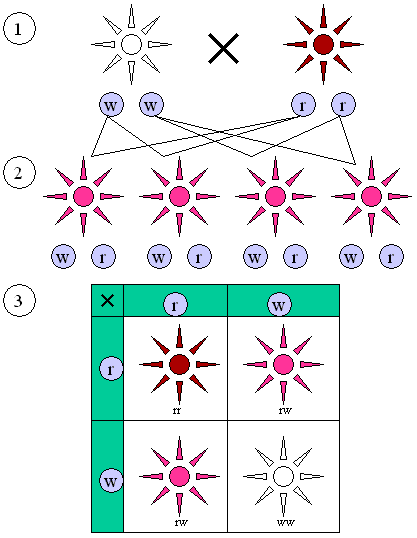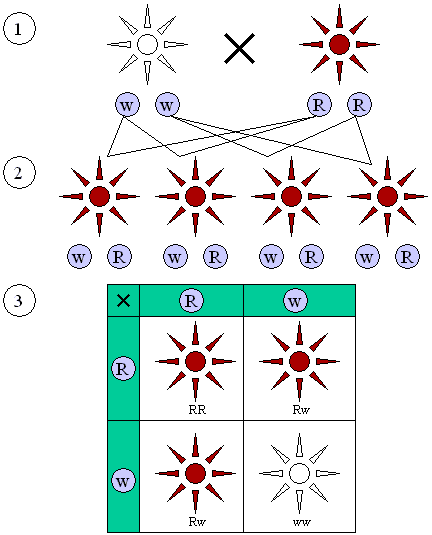Mendelian inheritance
|
|
Mendelian inheritance (or Mendelian genetics or Mendelism) is a set of primary tenets that underlie much of genetics developed by Gregor Mendel in the latter part of the 19th century. Mendel (1822-1884), an Austrian monk, was interested in understanding variances in plants, and between 1856 and 1863 cultivated and tested some 28,000 pea plants. His experiments brought forth two generalizations which later became known as Mendel's Laws of Heredity or Mendelian inheritance. These are described in his paper "Experiments on Plant Hybridization" that was read to the Natural History Society of Brunn on February 8 and March 8, 1865, and was published in 1866.
Before Gregor Mendel formulated his theories of genetics in 1865, the prevailing theory of biological inheritance was that of blending inheritance, in which the sperm and egg of parent organisms contained a sampling of the parent's "essence" and that they somehow blended together to form the pattern for the offspring. This theory accounted for the fact that offspring tended to resemble their parents without all members of a population eventually averaging themselves out.
Mendel proposed instead a theory of particulate inheritance, in which characteristics were determined by discrete units of inheritance that were passed intact from one generation to the next. These units would later come to be known as genes, though Mendel did not coin the term himself. Mendel based his theory on experiments involving the cross-pollination between two plants or self-pollination with a single plant. Based on many years of careful, tedious breeding experiments, Mendel developed several fundamental laws of Mendelian inheritance.
Mendel's law of independent assortment
- Also known as Mendel's Second Law
The most important principle of Mendel's law of independent assortment is that the emergence of one trait will not affect the emergence of another. While his experiments mixing one trait always resulted in a 3:1 ratio (Fig. 1) between dominant and recessive phenotypes, his experiments with two traits showed 9:3:3:1 ratios (Fig. 2). Mendel concluded that each organism carries two sets of information about its phenotype. If the two sets differ on the same phenotype, one of them dominates the other. That way, information can be passed on through the generations, even if the phenotype is not expressed (F1 generations, figures 1 and 2).
Mendelian_inheritance_9_3_3_1.PNG
(1) Parental generation. (2) F1 generation. (3) F2 generation.
Results : 9x short black hair, 3x long black hair, 3x short white hair, 1x long white hair.
Mendel's findings allowed other scientists to simplify the emergence of traits to mathematical probability. A large portion of Mendel's spectacular findings can be traced to his choice to start his experiments only with true breeding plants. He also only measured absolute characteristics such as color, shape, and position of the offspring. His data was expressed numerically and subjected to statistical analysis. This method of data reporting and the large sampling size he used gave credibility to his data. He also had the foresight to look through several successive generations of his pea plants and record their variations. Without his careful attention to procedure and detail, Mendel's work could not have had the impact it made on the world of genetics.
Mendel's law of segregation
Mendel's law of segregation essentially has three parts.
- Alternative versions of genes account for variations in inherited characters. This is the concept of alleles. Alleles are different versions of genes that impart the same characteristic. Each human has a gene that controls height, but there are variations among these genes in accordance with the specific height the gene "codes" for.
- For each character, an organism inherits two genes, one from each parent. This means that when somatic cells are produced from two gametes, one allele comes from the mother, one from the father. These alleles may be the same (true-breeding organisms, e.g. ww and rr in Fig. 3), or different (hybrids, e.g. wr in Fig. 3).
- If the two alleles differ, then one, the dominant allele, is fully expressed in the organism's appearance; the other, the segregate during gamete production. This is the last part of Mendel's generalization. The two alleles of the organism are separated into different gametes, ensuring variation.

(1) Parental generation. (2) F1 generation. (3) F2 generation. The "red" and "white" allele together make a "pink" phenotype, resulting in a 1:2:1 ratio of red:pink:white in the F2 generation.
During his experiments, Mendel encountered some traits that did not follow the laws he had encountered. These traits did not appear independently, but always together with at least one other trait. Mendel could not explain what happened and chose not to mention it in his work. Today, we know that these traits are linked on the same chromosome.de:Mendelsche Gesetze id:Hukum segregasi Mendel it:Leggi di Mendel ja:メンデルの法則 ko:멘델의 유전법칙 nl:Wetten van Mendel

